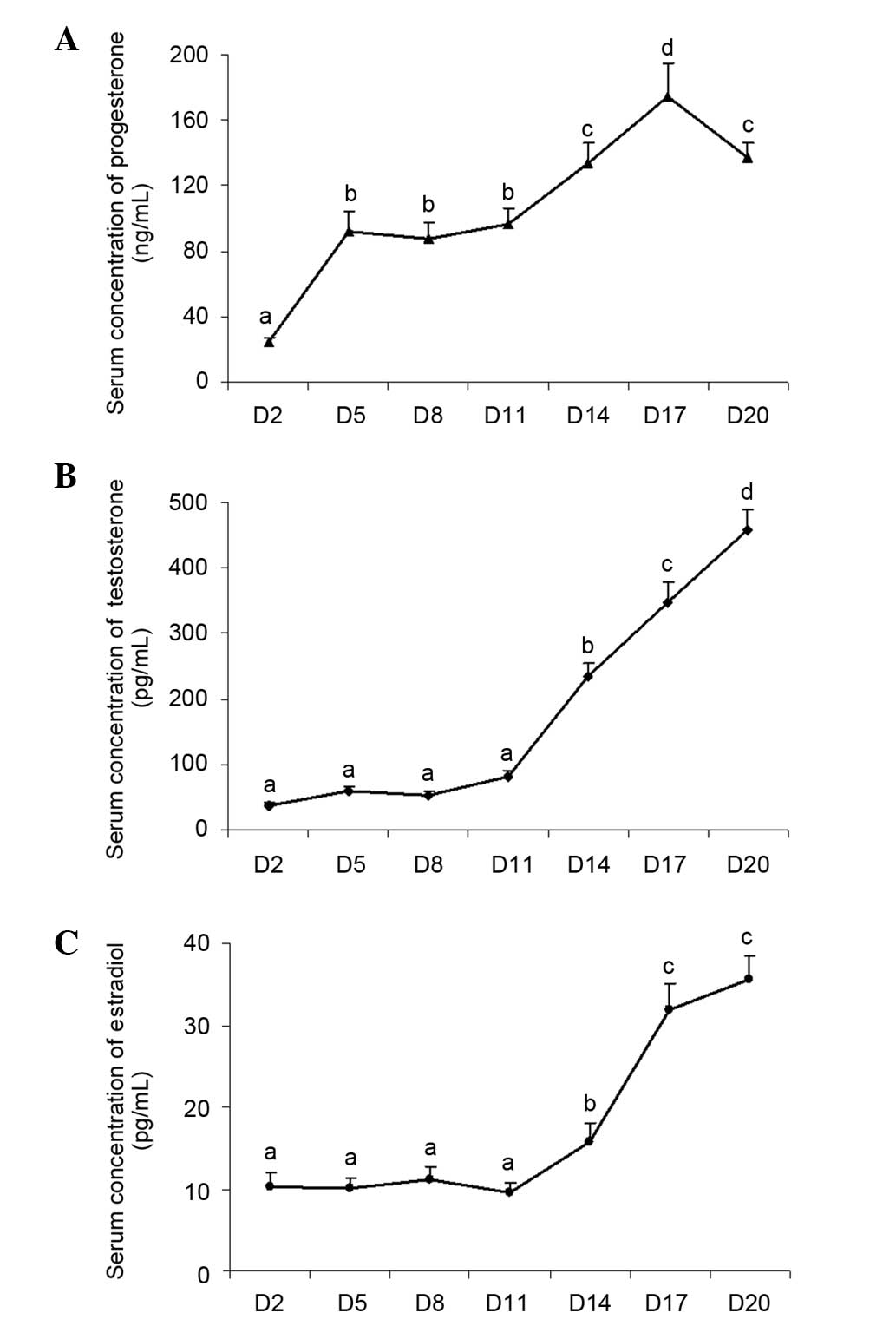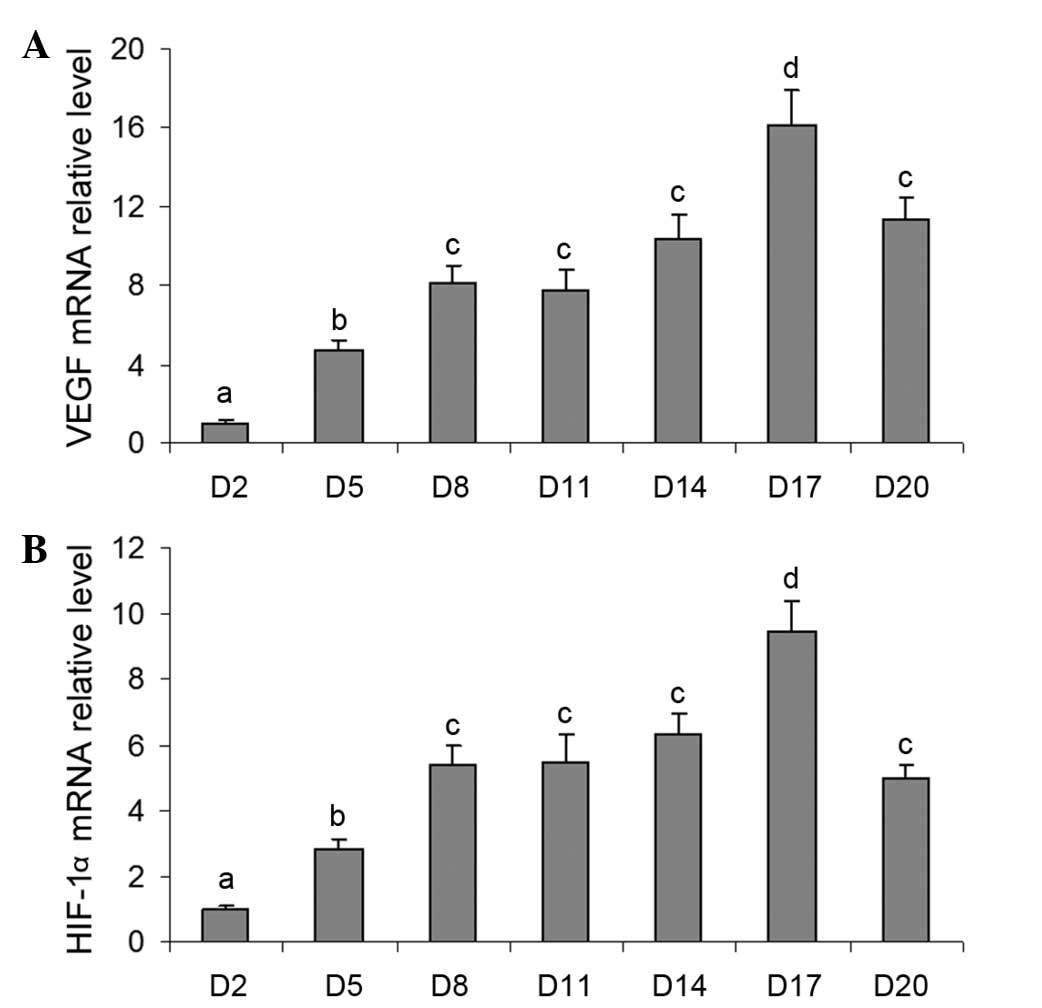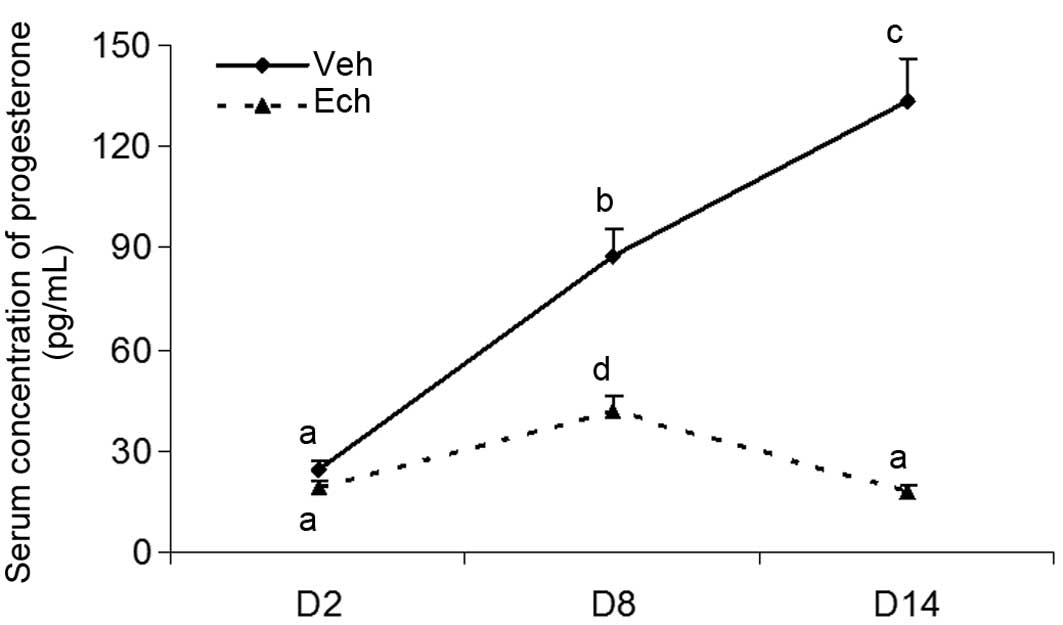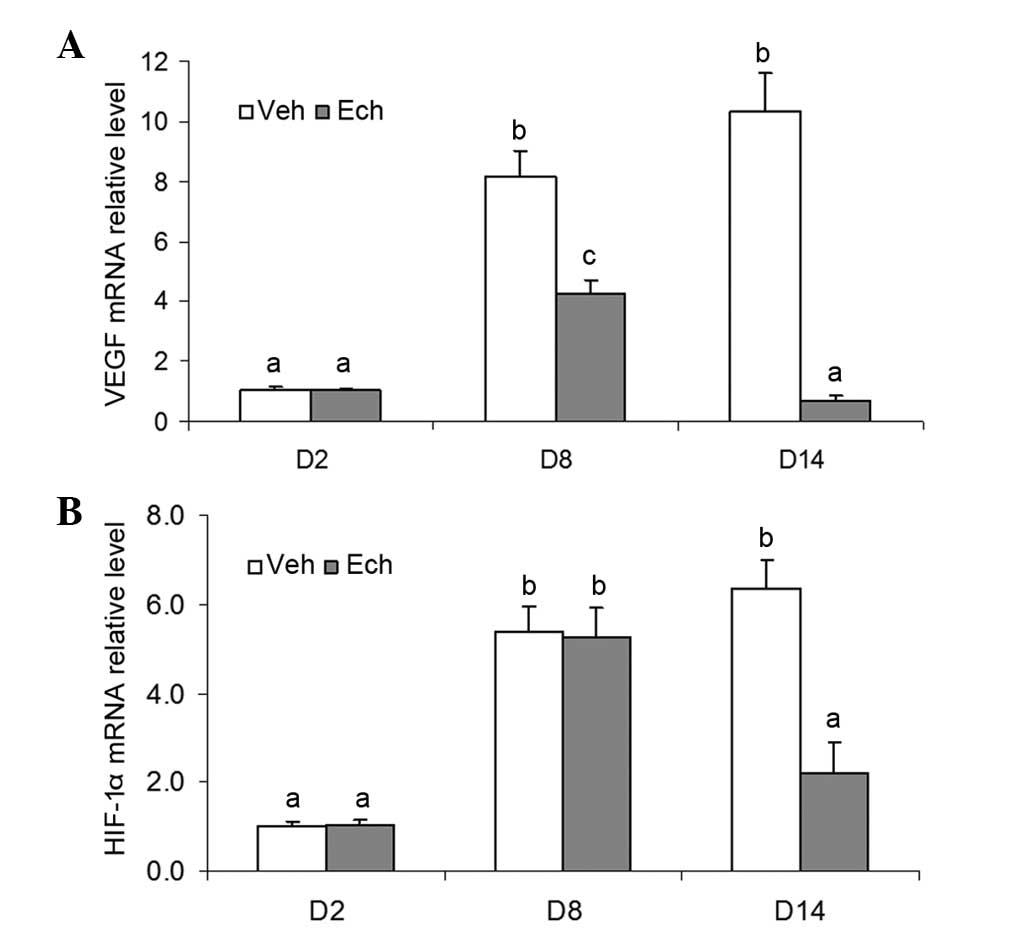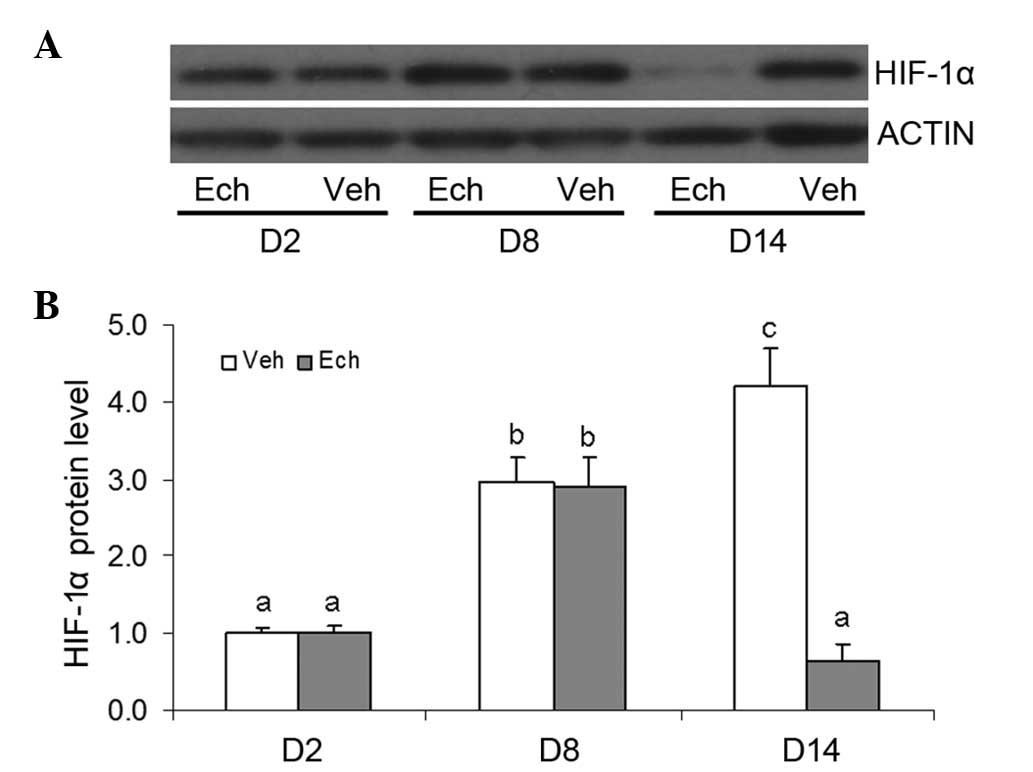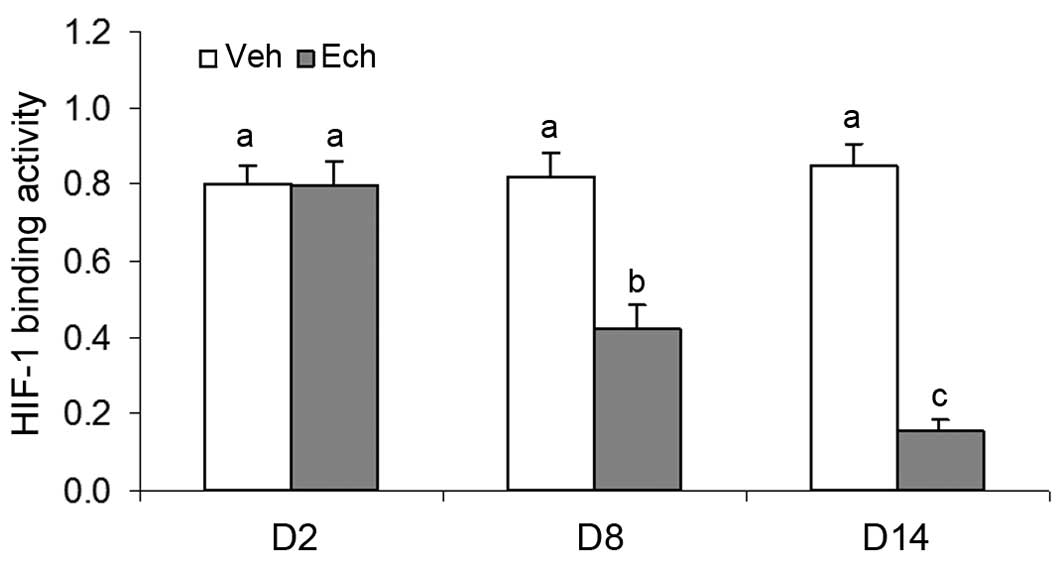|
1
|
Young FM, Rodger FE, Illingworth PJ and
Fraser HM: Cell proliferation and vascular morphology in the
marmoset corpus luteum. Hum Reprod. 15:557–66. 2000. View Article : Google Scholar : PubMed/NCBI
|
|
2
|
Wulff C, Dickson SE, Duncan WC and Fraser
HM: Angiogenesis in the human corpus luteum: Simulated early
pregnancy by HCG treatment is associated with both angiogenesis and
vessel stabilization. Hum Reprod. 16:2515–2524. 2001. View Article : Google Scholar : PubMed/NCBI
|
|
3
|
Fraser HM, Bell J, Wilson H, Taylor PD,
Morgan K, Abderson RA and Duncan WC: Localization and
quantification of cyclic changes in the expression of endocrine
gland vascular endothelial growth factor in the human corpus
luteum. J Clin Endocrinol Metab. 90:427–434. 2005. View Article : Google Scholar
|
|
4
|
Fraser HM and Duncan WC: Vascular
morphogenesis in the primate ovary. Angiogenesis. 8:101–116. 2005.
View Article : Google Scholar : PubMed/NCBI
|
|
5
|
Nishimura R and Okuda K: Hypoxia is
important for establishing vascularization during corpus luteum
formation in cattle. J Reprod Dev. 56:110–116. 2010. View Article : Google Scholar
|
|
6
|
Amselgruber WM, Schäfer M and Sinowatz F:
Angiogenesis in the bovine corpus luteum: An immunocytochemical and
ultra-structural study. Anat Histol Embryol. 28:157–166. 1999.
View Article : Google Scholar : PubMed/NCBI
|
|
7
|
Semenza GL: HIF-1: Mediator of
physiological and pathophysiological responses to hypoxia. J Appl
Physiol. 88:1474–1480. 2000.PubMed/NCBI
|
|
8
|
Semenza GL: Expression of
hypoxia-inducible factor 1: Mechanisms and consequences. Biochem
Pharmacol. 59:47–53. 2000. View Article : Google Scholar
|
|
9
|
Zhang Z, Yin D and Wang Z: Contribution of
hypoxia-inducible factor-1α to transcriptional regulation of
vascular endothelial growth factor in bovine developing luteal
cells. Anim Sci J. 82:244–250. 2011. View Article : Google Scholar : PubMed/NCBI
|
|
10
|
Molitoris KH, Kazi AA and Koos RD:
Inhibition of oxygen-induced hypoxia-inducible factor-1alpha
degradation unmasks estradiol induction of vascular endothelial
growth factor expression in ECC-1 cancer cells in vitro.
Endocrinology. 150:5405–5414. 2009. View Article : Google Scholar : PubMed/NCBI
|
|
11
|
Miyazawa M, Yasuda M, Fujita M,
Hirabayashi K, Hirasawa T, Kajiwara H, Muramatsu T, Miyazaki S,
Harasawa M, Matsui N, et al: Granulosa cell tumor with activated
mTOR-HIF-1alpha-VEGF pathway. J Obstet Gynaecol Res. 36:448–453.
2000. View Article : Google Scholar
|
|
12
|
Critchley HO, Osei J, Henderson TA,
Boswell L, Sales KJ, Jabbour HN and Hirani N: Hypoxia-inducible
factor-1alpha expression in human endometrium and its regulation by
prostaglandin E-series prostanoid receptor 2 (EP2). Endocrinology.
147:744–753. 2006. View Article : Google Scholar
|
|
13
|
Neulen J, Yan Z, Raczek S, Weindel K, Keck
C, Weich HA, Marmé D and Breckwoldt M: Human chorionic
gonadotropin-dependent expression of vascular endothelial growth
factor/vascular permeability factor in human granulosa cells:
Importance in ovarian hyperstimulation syndrome. J Clin Endocrinol
Metab. 80:1967–1971. 1995.PubMed/NCBI
|
|
14
|
Lee A, Christenson LK, Patton PE, Burry KA
and Stouffer RL: Vascular endothelial growth factor production by
human luteinized granulosa cells in vitro. Hum Reprod.
12:2756–2761. 1997. View Article : Google Scholar
|
|
15
|
Shimizu T, Jayawardana BC, Tetsuka M and
Miyamoto A: Differential effect of follicle-stimulating hormone and
estradiol on expressions of vascular endothelial growth factor
(VEGF) 120, VEGF164 and their receptors in bovine granulosa cells.
J Reprod Dev. 53:105–112. 2007. View Article : Google Scholar
|
|
16
|
Shimizu T and Miyamoto A: Progesterone
induces the expression of vascular endothelial growth factor (VEGF)
120 and Flk-1, its receptor, in bovine granulosa cells. Anim Reprod
Sci. 102:228–237. 2007. View Article : Google Scholar : PubMed/NCBI
|
|
17
|
van den Driesche S, Myers M, Gay E, Thong
KJ and Duncan WC: HCG up-regulates hypoxia inducible factor-1 alpha
in luteinized granulosa cells: Implications for the hormonal
regulation of vascular endothelial growth factor A in the human
corpus luteum. Mol Hum Reprod. 14:455–464. 2008. View Article : Google Scholar : PubMed/NCBI
|
|
18
|
Khandrika L, Lieberman R, Koul S, Kumar B,
Maroni P, Chandhoke R, Meacham RB and Koul HK: Hypoxia-associated
p38 mitogen-activated protein kinase-mediated androgen receptor
activation and increased HIF-1alpha levels contribute to emergence
of an aggressive phenotype in prostate cancer. Oncogene.
28:1248–1260. 2009. View Article : Google Scholar : PubMed/NCBI
|
|
19
|
Redmer DA and Reynolds LP: Angiogenesis in
the ovary. Rev Reprod. 1:182–192. 1996. View Article : Google Scholar : PubMed/NCBI
|
|
20
|
Fraser HM and Wulff C: Angiogenesis in the
primate ovary. Reprod Fertil Dev. 13:557–566. 2001. View Article : Google Scholar
|
|
21
|
Fraser HM and Wulff C: Angiogenesis in the
corpus luteum. Reprod Biol Endocrinol. 1:882003. View Article : Google Scholar : PubMed/NCBI
|
|
22
|
Tamanini C and De Ambrogi M: Angiogenesis
in developing follicle and corpus luteum. Reprod Domest Anim.
39:206–216. 2004. View Article : Google Scholar : PubMed/NCBI
|
|
23
|
Koos RD: Increased expression of vascular
endothelial growth/permeability factor in the rat ovary following
an ovulatory gonadotropin stimulus: Potential roles in follicle
rupture. Biol Reprod. 52:1426–1435. 1995. View Article : Google Scholar : PubMed/NCBI
|
|
24
|
Nishimura R, Sakumoto R, Tatsukawa Y,
Acosta TJ and Okuda K: Oxygen concentration is an important factor
for modulating progesterone synthesis in bovine corpus luteum.
Endocrinology. 147:4273–4280. 2006. View Article : Google Scholar : PubMed/NCBI
|
|
25
|
Zhang Z, Yu D, Yin D and Wang Z:
Activation of PI3K/mTOR signaling pathway contributes to induction
of vascular endothelial growth factor by hCG in bovine developing
luteal cells. Anim Reprod Sci. 125:42–48. 2011. View Article : Google Scholar : PubMed/NCBI
|
|
26
|
Zhang Z, Pang X, Tang Z, Yin D and Wang Z:
Overexpression of hypoxia-inducible factor prolyl hydoxylase-2
attenuates hypoxia-induced vascular endothelial growth factor
expression in luteal cells. Mol Med Report. 12:3809–3814. 2015.
|
|
27
|
Wang Z, Tang L, Zhu Q, Yi F, Zhang F, Li
PL and Li N: Hypoxia-inducible factor-1α contributes to the
profibrotic action of angiotensin II in renal medullary
interstitial cells. Kidney Int. 79:300–310. 2011. View Article : Google Scholar :
|
|
28
|
Wang Z, Zhu Q, Li PL, Dhaduk R, Zhang F,
Gehr TW and Li N: Silencing of hypoxia-inducible factor-1α gene
attenuates chronic ischemic renal injury in two-kidney, one-clip
rats. Am J Physiol Renal Physiol. 306:1236–1242. 2014. View Article : Google Scholar
|
|
29
|
Wang Z, Zhu Q, Xia M, Li PL, Hinton SJ and
Li N: Hypoxia-inducible factor prolylhydroxylase 2 senses high-salt
intake to increase hypoxia inducible factor 1alpha levels in the
renal medulla. Hypertension. 55:1129–1136. 2010. View Article : Google Scholar : PubMed/NCBI
|
|
30
|
Kaczmarek MM, Schams D and Ziecik AJ: Role
of vascular endothelial growth factor in ovarian physiology-An
overview. Reprod Biol. 5:111–136. 2005.PubMed/NCBI
|
|
31
|
Ravindranath N, Little-Ihrig L, Phillips
HS, Ferrara N and Zeleznik AJ: Vascular endothelial growth factor
messenger ribonucleic acid expression in the primate ovary.
Endocrinology. 131:254–260. 1992.PubMed/NCBI
|
|
32
|
Christenson LK and Stouffer RL:
Follicle-stimulating hormone and luteinizing hormone/chorionic
gonadotropin stimulation of vascular endothelial growth factor
production by macaque granulosa cells from pre- and periovulatory
follicles. J Clin Endocrinol Metab. 82:2135–2142. 1997.PubMed/NCBI
|
|
33
|
Endo T, Kitajima Y, Nishikawa A, Manase K,
Shibuya M and Kudo R: Cyclic changes in expression of mRNA of
vascular endothelial growth factor, its receptors Flt-1 and
KDR/Flk-1 and Ets-1 in human corpora lutea. Fertil Steril.
76:762–768. 2001. View Article : Google Scholar : PubMed/NCBI
|
|
34
|
Tesone M, Stouffer RL, Borman SM,
Hennebold JD and Molskness TA: Vascular endothelial growth factor
(VEGF) production by the monkey corpus luteum during the menstrual
cycle: Isoform-selective messenger RNA expression in vivo and
hypoxia-regulated protein secretion in vitro. Biol Reprod.
73:927–934. 2005. View Article : Google Scholar : PubMed/NCBI
|
|
35
|
Tropea A, Miceli F, Minici F, Tiberi F,
Orlando M, Gangale MF, Romani F, Catino S, Mancuso S, Navarra P, et
al: Regulation of vascular endothelial growth factor synthesis and
release by human luteal cells in vitro. J Clin Endocrinol Metab.
91:2303–2309. 2006. View Article : Google Scholar : PubMed/NCBI
|
|
36
|
Fraser HM, Wilson H, Wulff C, Rudge JS and
Wiegand SJ: Administration of vascular endothelial growth factor
Trap during the 'post-angiogenic' period of the luteal phase causes
rapid functional luteolysis and selective endothelial cell death in
the marmoset. Reproduction. 132:589–600. 2006. View Article : Google Scholar : PubMed/NCBI
|
|
37
|
Duncan WC, van den Driesche S and Fraser
HM: Inhibition of vascular endothelial growth factor in the primate
ovary up-regulates hypoxia-inducible factor-1alpha in the follicle
and corpus luteum. Endocrinology. 149:3313–3320. 2008. View Article : Google Scholar : PubMed/NCBI
|
|
38
|
Nastri CO, Ferriani RA, Rocha IA and
Martins WP: Ovarian hyperstimulation syndrome: Pathophysiology and
prevention. J Assist Reprod Genet. 27:121–128. 2010. View Article : Google Scholar : PubMed/NCBI
|
|
39
|
Fraser HM and Lunn SF: Angiogenesis and
its control in the female reproductive system. Br Med Bull.
56:787–797. 2000. View Article : Google Scholar
Duncan WC, van den Driesche S and Fraser
HM: Inhibition of vascular endothelial growth factor in the primate
ovary up-regulates hypoxia-inducible factor-1alpha in the follicle
and corpus luteum. Endocrinology. 149:3313–3320. 2008. View Article : Google Scholar : PubMed/NCBI
|
|
40
|
Wang GL, Jiang BH, Rue EA and Semenza GL:
Hypoxia-inducible factor 1 is a basic-helix-loop-helix-PAS
heterodimer regulated by cellular O2 tension. Proc Natl Acad Sci
USA. 92:5510–5514. 1995. View Article : Google Scholar : PubMed/NCBI
|
|
41
|
Zhong H, Chiles K, Feldser D, Laughner E,
Hanrahan C, Georgescu MM, Simons JW and Semenza GL: Modulation of
hypoxia-inducible factor 1alpha expression by the epidermal growth
factor/phosphatidylinositol 3-kinase/PTEN/AKT/FRAP pathway in human
prostate cancer cells: Implications for tumor angiogenesis and
therapeutics. Cancer Res. 60:1541–1545. 2000.PubMed/NCBI
|
|
42
|
Yaba A, Bianchi V, Borini A and Johnson J:
A putative mitotic checkpoint dependent on mTOR function controls
cell proliferation and survival in ovarian granulosa cells. Reprod
Sci. 15:128–138. 2008. View Article : Google Scholar : PubMed/NCBI
|
|
43
|
Miyazawa M, Yasuda M, Fujita M, Kajiwara
H, Hirabayashi K, Takekoshi S, Hirasawa T, Murakami M, Ogane N,
Kiguchi K, et al: Therapeutic strategy targeting the
mTOR-HIF-1alpha-VEGF pathway in ovarian clear cell adenocarcinoma.
Pathol Int. 59:19–27. 2009. View Article : Google Scholar : PubMed/NCBI
|
|
44
|
Kazi AA, Jones JM and Koos RD: Chromatin
immunoprecipitation analysis of gene expression in the rat uterus
in vivo: Estrogen-induced recruitment of both estrogen receptor
alpha and hypoxia-inducible factor 1 to the vascular endothelial
growth factor promoter. Mol Endocrinol. 19:2006–2019. 2005.
View Article : Google Scholar : PubMed/NCBI
|
|
45
|
Kazi AA and Koos RD: Estrogen-induced
activation of hypoxia-inducible factor-1alpha, vascular endothelial
growth factor expression, and edema in the uterus are mediated by
the phosphatidylinositol 3-kinase/Akt pathway. Endocrinology.
148:2363–2374. 2007. View Article : Google Scholar : PubMed/NCBI
|
|
46
|
Chan DA and Giaccia AJ: PHD2 in tumour
angiogenesis. Br J Cancer. 103:1–5. 2010. View Article : Google Scholar : PubMed/NCBI
|



